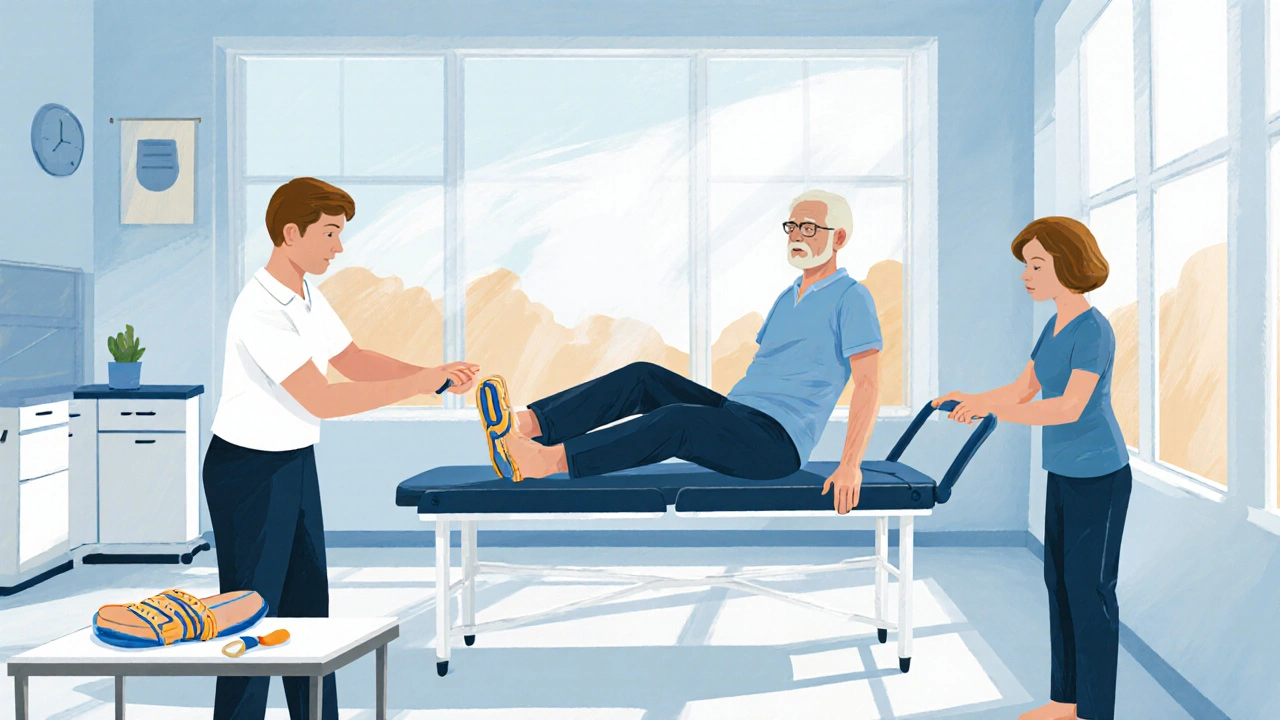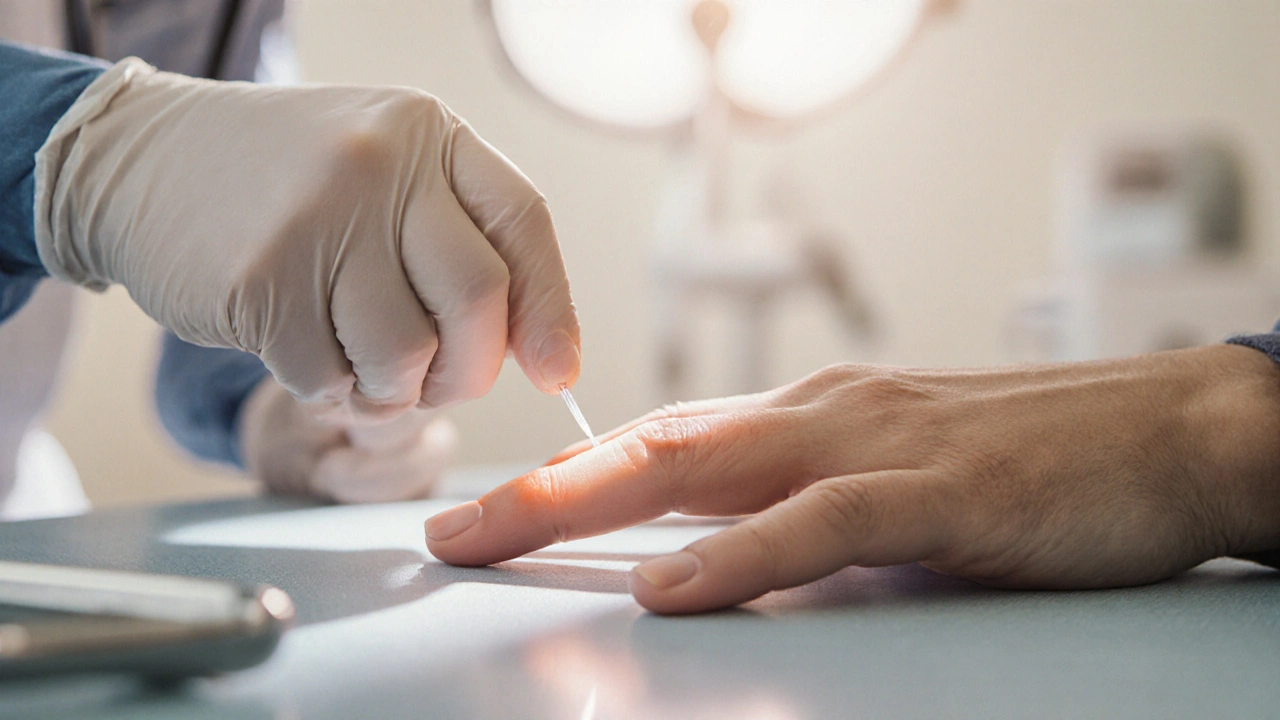When dealing with Leprosy is a chronic infectious disease caused by Mycobacterium leprae that primarily attacks skin and peripheral nerves, the link to lasting impairment often goes unnoticed until it’s too late. This article breaks down why the disease can lead to disability, how early detection changes the outcome, and what practical steps you can take to prevent or reverse functional loss.
How Leprosy Leads to Disability
Understanding the pathway from infection to impairment starts with the bacteria’s favorite playground: peripheral nerves. Once Nerve Damage in leprosy manifests as loss of sensation, muscle weakness, and autonomic dysfunction, patients can’t feel burns, cuts, or pressure. Those unnoticed injuries quickly become infected, leading to ulcers, contractures, and ultimately loss of limb function.
Two key factors push the situation toward permanent disability:
- Delayed diagnosis - without timely treatment, nerve damage progresses unchecked.
- Social stigma - fear of being ostracized often stops people from seeking help early.
When both align, the result is a cascade of preventable complications that can cripple a person’s independence.
Early Detection Saves Function
Spotting leprosy before nerves are severely compromised is the single most powerful weapon against disability. The World Health Organization recommends community‑based screening and education to catch cases early, especially in endemic regions.
Watch for these early signs:
- Persistent skin patches that are lighter or darker than surrounding areas.
- Loss of feeling in hands, feet, or face.
- Muscle weakness causing difficulty gripping objects.
If any appear, a simple skin smear or a quick nerve function test can confirm the diagnosis. Starting treatment at this stage dramatically reduces the risk of permanent impairment.
Prevention Strategies to Stop Disability
Preventing disability isn’t just about medicine; it’s a blend of clinical, behavioral, and community actions.
Leprosy disability prevention hinges on three pillars:
- Effective pharmacotherapy - The standard Multi-Drug Therapy (MDT) combines dapsone, rifampicin, and clofazimine to kill the bacteria and halt disease progression. A full 6‑12‑month course clears the infection in over 95% of cases.
- Protective self‑care - Daily skin inspections, wearing padded shoes, and using moisturizers keep the skin barrier intact.
- Community education - Teaching families that leprosy is treatable eliminates fear and encourages early health‑seeking behavior.
Implementing these steps reduces the chance of nerve damage by up to 80% according to recent field studies in Brazil and India.

Rehabilitation Options After Nerve Damage
When some nerve loss has already occurred, rehabilitation can restore a large portion of function. The goal is to train remaining muscles, prevent contractures, and provide tools that compensate for lost sensation.
| Approach | Primary Benefit | Typical Duration |
|---|---|---|
| Physical Therapy focuses on strengthening muscles, improving balance, and preserving joint range | Restores mobility and reduces pain | 3-6 months, then maintenance |
| Occupational Therapy teaches adaptive techniques for daily living tasks | Enhances independence in self‑care | 2-4 months, with periodic follow‑up |
| Assistive Devices include custom footwear, splints, and sensory feedback tools | Compensates for loss of sensation | Custom‑fit, lifelong use |
Physical therapy is often the first line, especially when muscle weakness is the main issue. Occupational therapists step in to retrain fine motor tasks-like buttoning shirts or cooking-by suggesting modified grips or tool aids.
Assistive devices deserve special mention because they bridge the sensory gap. Padded insoles prevent foot ulcers, while pressure‑sensing gloves alert users when they grip too hard.
Rehabilitation isn’t a one‑size‑fits‑all process. Each plan should be tailored to the individual’s remaining sensation, cultural context, and personal goals.
Managing Stigma and Social Inclusion
Even with perfect medical care, disability can spiral if the community isolates the affected person. Stigma fuels depression, reduces treatment adherence, and can even revert functional gains.
Key actions to break the cycle:
- Storytelling campaigns featuring cured individuals showcase that leprosy is treatable.
- Integrating former patients into local health committees builds trust and visibility.
- Providing livelihood training-like craft workshops-helps restore economic independence.
When people see the disease as a medical condition rather than a moral failing, compliance with medication and rehab rises dramatically.

Practical Checklist for Patients and Caregivers
Keep this quick reference handy to ensure no step is missed.
- Schedule a skin and nerve exam at the first sign of a patch or numbness.
- Start MDT as prescribed; finish the full course even if symptoms improve.
- Inspect skin daily; use a mirror for hard‑to‑see areas.
- Wear protective shoes and socks; replace them every six months.
- Join a local support group to share experiences and resources.
- Consult a physical therapist within two weeks of diagnosis to begin mobility exercises.
- Ask an occupational therapist for adaptive tools tailored to daily routines.
- Discuss with a clinician whether custom assistive devices are needed.
- Report any new ulcers or worsening weakness to a healthcare provider immediately.
Following this checklist can keep disability at bay and help anyone already affected regain a richer quality of life.
Frequently Asked Questions
Can leprosy be cured completely?
Yes. The WHO‑recommended Multi‑Drug Therapy clears the bacteria in more than 95% of patients when the full regimen is completed. Early treatment also prevents most nerve damage.
What is the earliest sign of nerve involvement?
Loss of sensation in a patch of skin or on a fingertip is often the first clue. A simple monofilament test can detect even subtle numbness.
How long does rehabilitation usually last?
Intensive therapy typically spans 3‑6 months for physical therapy and 2‑4 months for occupational therapy. Maintenance visits continue as needed, especially when new injuries occur.
Are assistive devices covered by insurance?
Coverage varies by country and plan, but many public health programs in endemic regions subsidize custom footwear and splints. It’s worth checking local disability benefits.
What can families do to reduce stigma?
Educate relatives about the disease’s treatability, involve the patient in community activities, and share success stories to change perceptions.



10 Comments
Halle Redick October 13, 2025 AT 20:55
What a solid rundown on leprosy’s impact! Early detection truly is the game‑changer, and community screening can catch those subtle skin patches before nerves go rogue. I love the emphasis on daily self‑care – a quick foot check each morning can save a lot of trouble later. Also, getting families involved breaks down that nasty stigma you mentioned. Keep spreading the word, folks, because knowledge is our best defense.
Max Canning October 14, 2025 AT 02:28
Get those shoes on the daily and keep checking those feet!
Nick Rogers October 14, 2025 AT 08:01
Early screening, combined with prompt MDT, dramatically reduces the risk of permanent nerve loss.
Tesia Hardy October 14, 2025 AT 13:35
Totally agree that daily skin inspections are key – I even set a reminder on my phone so I dont forget. Using padded shoes is a small step that makes a huge diffference, especially for people workin outdoors.
Matt Quirie October 14, 2025 AT 19:08
It is commendable, indeed, that the guide highlights multi‑drug therapy; however, one must also consider the necessity of consistent follow‑up appointments, which are essential for monitoring potential drug resistance, and ensuring adherence, especially in remote areas.
Pat Davis October 15, 2025 AT 00:41
The data from Brazil and India is compelling evidence that integrated community education, protective footwear, and timely pharmacotherapy can cut disability rates by up to 80 percent. Governments should allocate resources accordingly.
Mary Wrobel October 15, 2025 AT 06:15
Imagine a world where every patient wears a splash of color‑tinted socks, not just for style but as a reminder to inspect their feet. That creative twist can transform routine care into a joyful habit.
Michelle Guatato October 15, 2025 AT 11:48
Everyone talks about stigma like it’s just social pressure, but think about who benefits when patients stay hidden. The pharmaceutical lobby profits when treatments are delayed, ensuring a steady market for chronic care supplies. It’s no coincidence that stigma spikes right before major drug roll‑outs are announced.
Jenn Zee October 15, 2025 AT 17:21
One cannot overlook the profound ethical responsibility that lies upon the shoulders of public health officials when confronting a disease as historically burdened with prejudice as leprosy. The very notion that a treatable bacterial infection should cascade into social ostracism reflects a failure of collective moral imagination. It is incumbent upon societies, particularly those embroiled in endemicity, to dismantle archaic narratives that conflate contagion with moral deficiency. Moreover, the systematic neglect of rehabilitative services betrays a deep‑seated inequity that privileges the able‑bodied while discarding the vulnerable. The guide’s emphasis on community education is a step forward, yet it remains insufficient without concurrent policy reforms that guarantee universal access to assistive devices. When governments allocate resources solely to pharmacotherapy, they implicitly endorse a model of cure that ignores the lived reality of post‑treatment disability. This myopic approach reduces individuals to statistics, stripping them of agency and dignity. Parallel to this, cultural ambassadors must be empowered to champion narratives that celebrate recovery and reintegration rather than perpetuate fear. The intersection of medical science and sociocultural dynamics demands a holistic strategy, one that fuses early detection with sustained psychosocial support. In practice, this translates to robust funding for occupational therapy, inclusive educational curricula, and public campaigns that humanize affected persons. Only through such comprehensive measures can we begin to rectify the historical injustices woven into the fabric of leprosy management. The checklist provided is exemplary, but its effectiveness hinges on the unwavering commitment of both local leaders and international bodies. In sum, the journey from infection to disability is not merely a biological cascade; it is a social construct that can be dismantled through concerted, compassionate action.
Steph Hooton October 15, 2025 AT 22:55
Well put, Jenn. I concur that policy must evolve alongside medical advances, and community empowerment is essential for lasting change.